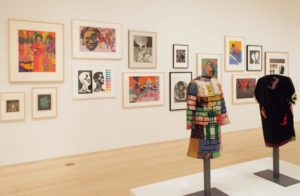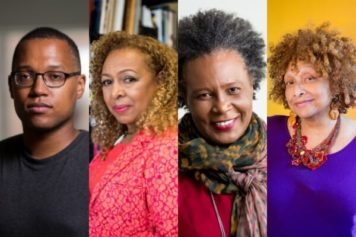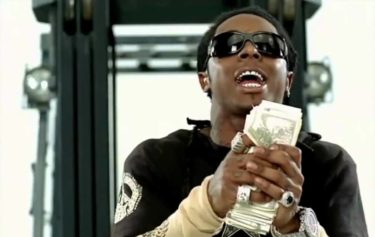
We Wanted a Revolution: Black Radical Women, 1965-85 Installation Views. (C) Jonathan Dorado.
The female African-American experience is center stage in the Brooklyn Museum’s art exhibition “We Wanted a Revolution: Black Radical Women, 1965–85.” The exhibit, which the art website Hyperallergic described as “perhaps the most important exhibition New York has seen in recent years,” highlights the work of Black women during a period of tremendous cultural and sociopolitical upheaval.
The 20-year time frame the exhibit spans notably gave rise to the women’s liberation movement, but many Black women felt marginalized by mainstream white feminism. They began to identify as womanists (coined by “The Color Purple” author Alice Walker) rather than as feminists to embrace their specific take on women’s liberation and the double jeopardy they experienced being both Black and female in a white supremacist and patriarchal society. And Black women artists felt sidelined by the art world as well. The marginalization they faced did not prevent them from creating, however. In fact, Black women artists flourished during this time.
The Brooklyn Museum show highlighting their accomplishments is part of a yearlong series of exhibitions marking the 10th anniversary of the Elizabeth A. Sackler Center for Feminist Art. Rujeko Hockley and Catherine Morris co-curated “We Wanted a Revolution.” The exhibit will run through Sept. 17, and the Brooklyn Museum has described the uniqueness of this assemblage of art, featuring more than 200 works.
“It is the first exhibition to highlight the voices and experiences of women of color — distinct from the primarily white, middle-class mainstream feminist movement — in order to reorient conversations around race, feminism, political action, art production, and art history in this significant historical period,” the museum states on its website.
“Presenting a diverse group of artists and activists who lived and worked at the intersections of avant-garde art worlds, radical political movements, and profound social change, the exhibition features a wide array of work, including conceptual, performance, film, and video art, as well as photography, painting, sculpture, and printmaking.”
The exhibit features too many artists to name, but among them are Faith Ringgold, Julie Dash, Lorna Simpson, Carrie Mae Weems, Kay Brown, Susan Robeson and Blondell Cummings. The cultural output of these women and other artists is featured in several galleries at the museum. In addition to individual artists, the exhibit highlights groups of artists, such as the Spiral Artist Collective and the subsequent Black Arts Movement, and how Black women fared in these collectives.
Remarkably, “We Wanted a Revolution” shows how the social issues of importance to the Black community during the 1965-85 time frame, such as the prison industrial complex, are much the same today. For example, it includes Faith Ringgold’s work “For the Women’s House.” In 1971, Ringgold displayed the work, which features a multicultural group of women in various roles — doctor, athlete, policewoman, musician — in the Women’s House of Detention at Rikers Island, where she had taken up an unconventional residency. She created the work at the request of the incarcerated women.
“Many of them voiced the opinion that they wanted to be able to see women being things in the world other than some of the things they had gotten arrested for,” she told the New Yorker in 2010. “They wanted to be able to do things in the world that were important other than being somebody’s girlfriend.”
Ringgold visited the prison because Angela Davis was incarcerated (in another location) at the time, and the artist became concerned about her and other women inmates. Davis, who famously studied at the Sorbonne, appreciated African-American artists, calling the Black arts movement “extremely important.” That movement, spearheaded by poet Amiri Baraka, was an outgrowth of the Black power movement. It included poets, writers, playwrights and musicians who embraced a political consciousness shaped by the desire for Black liberation.
Black female friendship is also the subject of the works featured in “We Wanted a Revolution,” as is the way in which Black artists advocated for other artists by helping to publicize their work. Moreover, historical documents paint a deeper picture of the art world at the time, including its stinging exclusion women of color. As Hyperallergic notes:
“Through reams of historical documents and papers, the curators unflinchingly recount instances of racism and exclusion, from the feminist cooperative AIR Gallery to Donald Newman’s controversial 1979 ‘Nigger Drawings’ show at Artists Space and even the Brooklyn Museum itself. During a town hall event at the institution in 1971, its director at the time, Duncan Cameron, appeared open to criticism yet ostensibly defended the museum’s exclusionary practices regarding the women and minority artists who were vying for representation; there was widespread outcry.”
Ringgold and other activist artists helped to hold Cameron accountable. He ended up resigning in 1973.
Artists such as Howardena Pindell were keenly aware of the impact racial microaggressions, such as those suffered by Blacks in the art field, had on African-Americans. Her video installation “Free White and 21” explores the minor but persistent racial slights that serve to traumatize Blacks. Other artwork questions what kind of political activism constitutes radicalism, the intersection of race and sexual orientation, and how Black men artists marginalized Black women as well as the white art world. Yet, Black women artists still stood by Black men. The Combahee River Collective, made up of Black LGBT women artists, said as much in its 1974 mission statement.
“Although we are feminists and Lesbians, we feel solidarity with progressive Black men and do not advocate the fractionalization that white women who are separatists demand,” the statement said. “We struggle together with Black men against racism, while we also struggle with Black men about sexism.”
Despite the challenges Black women artists faced, they persisted, demanding equality whether it regarded race, sex or gender. Through “We Wanted a Revolution,” their efforts finally receive the recognition they have long deserved.


